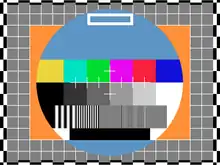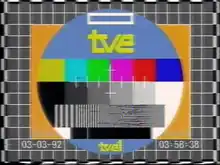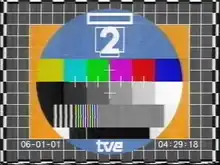
The TVE colour test card (Spanish: Carta de ajuste[1][2] en color de TVE) was an electronic analogue TV test card adopted by Televisión Española with the introduction of PAL colour broadcasts[3] in 1975.[4][5] It is notable for its unique design, created by the Danish engineer Finn Hendil (1939–2011)[6] in 1973,[7] under the supervision of Erik Helmer Nielsen at the Philips TV & Test Equipment laboratory in Amager, south of Copenhagen,[8][9] the same team that developed the popular Philips PM5544 test pattern.[10] It replaced a previous black and white version developed by Eduardo Gavilán.[6]


The test card was considered to be part of the regular TV schedule, figuring among daily program listings published in newspapers and magazines.[1][11] It was said to be the most viewed program in some days due to people watching the test card while waiting for broadcasts to start in the afternoon.[4][12][13] It was also relevant in the context of general work strikes, where the test card was sometimes broadcast in place of regular programming, marking it a visible sign of the strike's success.[14][15]
It was used on several TVE channels, like TVE 1,[16] TVE 2,[17][18] Canal Clásico,[19] Teledeporte[20] or TVE Internacional.[21]
With the start of continuous 24-hour broadcasting on TVE's channels, the test card was phased out. It stopped being broadcast on La Primera in 1996 and on La 2 in the early morning hours of 6 January 2001,[22] although it continued to be broadcast sporadically on Teledeporte and TVE Internacional until 2005.[9]
Operation and features
As Televisión Española adopted the PAL colour system in 1975,[4][5] the test card has specific elements that allow proper colour adjustments. Being a creation of the same team behind the Philips PM5544 test card,[8][9] it has many elements in common with it (like colour and grey bars or castellations[10]), but introduces some differences (for example, different resolution gratings and coloured background rectangle and circle).
There were two generations of the TVE test card. The original was generated by a heavily modified PM5544 which displays the station name at the bottom of the circle using a programmable character generator.[23] From the early 1990s onwards the appearance of the test card changed, with the station name becoming a graphic and clock font now being identical to that of the PM5644 (which was available by that time and likely to explain such changes) thus the original hardware was likely replaced.
Castellations
The alternating white and black boxes around the perimeter are called castellations. They are used to set overscan (castellations should be visible) and check for the low-frequency response of the entire transmission chain.
Grid
The background features a grid composed of perfect squares of 100% intensity white lines.
This element allows:
- Verify image geometry (horizontal and vertical size and linearity, cushion or barrel distortion effects);
- Adjust CRT convergence (the three electron guns, one for each primary color, need to target the same place);
- Adjust CRT focus;
- Check CRT color purity when displaying the 50% intensity gray background.
Rectangle
This element is composed of an orange rectangle, framed with a white line and located at the image center.
It allows for:
- Checking proper chrominance delay, essential for good PAL system operation;
- Visualizing low-frequency image distortions;
- Adjusting maximum color saturation.
Signal values of this element are:
| Color | Luminance | Chroma amplitude | Chroma Φ | Saturation |
|---|---|---|---|---|
| Orange | 0.66 | 0.369 | 135º | 0.99 |
Circle
This element is composed of a light blue circle, also located at the center of the image. With a diameter of 512 lines, it overlaps the rectangle mentioned previously. The circle provides a quick overview of image geometry.
Signal values of this element are:
| Color | Luminance | Chroma amplitude | Chroma Φ | Saturation |
|---|---|---|---|---|
| Light Blue | 0.45 | 0.169 | -45º | 0.87 |
Box
Located at the top of the circle and composed of 100% white lines, it allows for verification of the low-frequency response of the transmission chain.
Colour bars
Inside the circle, there's a section of colour bars with 75% amplitude and 100% saturation (EBU color bars), that allows checking chrominance parameters on a vectorscope or waveform monitor.
The signal values of these bars are:
| Color | Luminance | Chroma amplitude | Chroma Φ |
|---|---|---|---|
| Yellow | 0.67 | 0.336 | 167.1º |
| Cyan | 0.53 | 0.474 | 283.5º |
| Green | 0.44 | 0.443 | 240.7º |
| Magenta | 0.31 | 0.443 | 60.7º |
| Red | 0.23 | 0.474 | 103.5º |
| Blue | 0.086 | 0.336 | 347.1º |
Centre Grid
This element is composed of 100% white lines located at the centre of the image, between the colour bars and the greyscale. It helps with image centring adjustment and allows checking for CRT convergence at the centre of the screen.
Greyscale Bars
Beneath the colour bars there's a greyscale bar with six steps. This allows checking gamma correction of the television receiver, and linearity response of the transmission chain.
The brightness value of each steps varies with a ratio of 20%, as follows:
| 0% | 20% | 40% | 60% | 80% | 100% |
Grating Bars
Located within the circle, the gratings are composed of alternating white and black lines. Horizontal frequency response (horizontal resolution) can be determined by five frequency gratings of 0.5, 1.25, 2.25, 4.2, and 4.8 MHz. The last two gratings must show interference from the 4.43 MHz PAL colour carrier.
Pulse Signal
A pulse signal bar is placed under the frequency gratings, consisting of a black rectangle with a white vertical line, corresponding to a 2T pulse. This signal shows the status of the transmission chain at high frequencies, as well as ghosting due to signal echoes.
Station Identification
Other elements like TV network identification ("TVE","La Primera","TVE2","Teleporte","Canal Clásico","TVE Internacional"), specific TV channel logos or a clock were usually added to the test pattern.[16][17][18][19][20][21]
See also
References
- 1 2 Zarza, María de los Ángeles Alonso; Alarcón, Francisco Javier Fernández (July 30, 2014). Las preposiciones. Cambridge University Press. ISBN 9788498481297 – via Google Books.
- ↑ "El tesoro del Archivo de RTVE". RTVE.es. October 26, 2021.
- ↑ "La adopción del sistema de televisión en color PAL, reconocimiento de una realidad". El País. September 27, 1978.
- 1 2 3 Marín, Aitor (August 27, 2019). "La carta de ajuste: censuras, fallos y la verdadera función del que fue el 'programa' más visto". El País.
- 1 2
- García Calderón López, Eugenio (1981). Televisión, volumen II. Madrid: España. ISBN 84-7402-116-2.
- 1 2 Gallardo, Francisco (October 28, 2021). "La pantalla de nuestra vida" (PDF). Diario de Sevilla: 69.
- ↑ "Diário de Cadiz - Carte de ajuste para la cadena perpetua" – via PressReader.
- 1 2 "¿Sabes cuántos años cumple la "carta de ajuste" de la televisión?". Contenido Promocionado. October 19, 2017.
- 1 2 3 Fernández, José María (October 27, 2021). "TVE homenaje Chicho Ibáñez aniversario primera emisión televisiva". elcierredigital.com.
- 1 2 Hendil (1970). PHILIPS electronic measuring and microwave notes (1970|2) (PDF). PHILIPS. p. 1.
- ↑ Española, Radiotelevisión (February 7, 1988). "RTVE". RTVE – via Google Books.
- ↑ "Carta de Ajuste: Los técnicos exigían a TVE comenzar las emisiones antes de las 14:00 horas". FormulaTV.
- ↑ Sánchez-Mellado, Luz (July 21, 2017). "Yonquis de la carta de ajuste". El País.
- ↑ Biesca, Sergio Gávez (April 2, 2018). La gran huelga general: El sindicalismo contra la "modernización socialista". Siglo XXI de España Editores. ISBN 9788432318696 – via Google Books.
- ↑ Gómez, Rosario G. (December 13, 2020). "El día que la televisión se fue a negro". El País.
- 1 2 "TVE TEST CARD 1993" – via YouTube.
- 1 2 "TV-DX TVE-2 - Testcard and opening Circuit Catala 06.05.1984" – via YouTube.
- 1 2 "Spanish TV TVE2 Testcard 1999" – via YouTube.
- 1 2 "Canal Clasico Testbild (2004)" – via YouTube.
- 1 2 "Carta de ajuste Tele Deporte Testcard Testbild Testbeeld" – via YouTube.
- 1 2 "TVE Internacional startup | 23 December 1990" – via YouTube.
- ↑ Digital, Estrella (29 January 2022). "Diez años sin "La carta de ajuste"". Estrella Digital.
- ↑ "TV-DX / E4-TVE1-testcard" – via www.youtube.com.